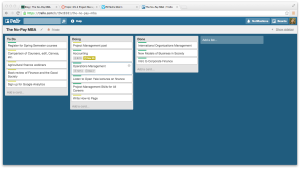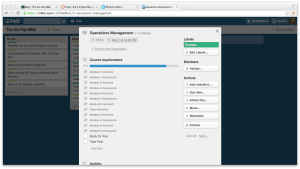by Laurie Pickard | Nov 24, 2013 | Courses, Platforms, and Profs
As first semester comes to a close, I will soon be enrolled in only one course. New Models of Business in Society ended a while back, International Organizations Management also wrapped up several weeks ago, and I’m preparing for finals in my two Wharton courses – Operations Management and Accounting. Until Spring Semester starts, my only course will be Project Management Skills for All Careers, through Canvas Network. It’s good timing for a lightened course load, since I just started a new job – hooray! (More on that in a future post.)
Project management is kind of my thing. Even though I haven’t studied it formally until now, project management is the bread and butter of my professional life. I am the type of person who gets truly excited about a well-designed spreadsheet, and creating a color-coded calendar is the type of thing I might do for fun, so I was a bit skeptical that this intro course geared towards accidental project managers would have anything to offer me.
I’m pleasantly surprised that already in the first two modules of my Canvas course we have covered some material that I have found interesting and enlightening.
The Difference Between Project Management and Operations Management
First, I was pleased to get a definition for project management as opposed to other kinds of management. To paraphrase from the textbook we are using for the course - a digital book with the same name as the course itself:
A project is temporary in nature and geared towards producing a unique outcome. It ends once it has met its goals and objectives or is cancelled if those goals and objectives cannot be met.
Managing a project is quite different from managing an ongoing process. The latter was the topic of my course in Operations Management, which was geared towards finding efficiencies in processes that are repeated again and again, over an indefinite period of time. In contrast, a project happens only once, so much of it is created new and is specific to the task at hand.
The Three Pillars of Project Management
Second, the course offered a helpful set of key considerations in any project, which are referred to as the three pillars of project management. These are:
- Cost,
- Schedule, and
- Scope/quality.
Inherent tradeoffs exist among these three pillars, as exemplified in this sign that was printed in our textbook, said to have come from an auto repair shop:
We do GOOD, CHEAP, and QUICK work.
You can have any two but not all three.
GOOD QUICK work won’t be CHEAP.
GOOD CHEAP work won’t be QUICK.
QUICK CHEAP work won’t be GOOD.
Visual Project Management
Third, and best of all, the course jumped right into practical techniques for managing projects. The method they started with is called visual project management. Imagine a white board with cards that represent tasks that must be completed as part of the project. The cards are organized into three columns: To Do, Doing, and Done. Several free web-based software programs offer virtual whiteboards and cards. I have started using one called Trello, and I am absolutely in love with it.
Here, you can see how I am organizing the No-Pay MBA. Cards with a green label are for courses, and those with a yellow label are for blog-related items.

If you click on any of these cards, the back of the card offers many other tools including checklists, deadlines, color-coded labels, email notifications, etc.

I’m excited to see where Project Management for All Careers goes next, but even if I don’t get anything else out of the course, I’ve gotten my money’s worth – and I’d feel the same even if the course weren’t free.
by Laurie Pickard | Nov 15, 2013 | MOOC MBA Design, Most popular posts
“A dollar today is worth more than a dollar tomorrow.” Most of us have probably heard someone say something to this effect. We understand intuitively that a dollar in hand is preferable to a dollar some future date. But why is this true?
Turns out it is possible to calculate exactly how much more a dollar today is worth than a dollar tomorrow, five years from now, or twenty years from now. The discount rate, otherwise known as the rate of inflation, can be used to take today’s dollar and translate it into future dollars – or to figure out how much a future amount of cash would be worth today.
This type of analysis is a powerful tool for determining whether a given investment is a good idea or not. To do this, you simply compare the amount of the investment to the predicted future cash flows from the investment, discounted back over the life of the project. Simple. This analysis is known as the net present value (NPV) of the investment - in other words, how much the whole investment is worth in today’s dollars.
What is the value of The No-Pay MBA? Or of any MBA for that matter? Answering this question is fairly simple – it just requires making a few assumptions.
First, let’s assume that the No-Pay MBA is not in fact completely free. Let’s say I end up spending around $1000 up front. This covers what I’m paying for internet access, web hosting, wear and tear on my computer, business books I’m buying, and other expenses.
Second, I’m assuming that there is no opportunity cost of The No-Pay MBA. It’s not taking time away from other employment, it’s not keeping me from doing any kind of paying work, and there is nothing else I could be doing with the time I spend working on my MBA that would result in monetary compensation.
Third, I’m assuming that I’ll be able to leverage this project to get a higher salary in the future. Let’s say as a result of having done the No-Pay MBA I’m able to earn $5,000 additional income per year starting a year after I finish.
Finally, I’m assuming a 3% interest rate.
The calculation can be done in Excel, and it looks something like this:
| Year |
Additional income or expense |
NPV |
|
0
|
$(1,000.00)
|
$(1,000.00)
|
|
1
|
$-
|
$-
|
|
2
|
$-
|
$-
|
|
3
|
$5,000.00
|
$4,575.71
|
|
4
|
$5,000.00
|
$4,442.44
|
|
5
|
$5,000.00
|
$4,313.04
|
|
6
|
$5,000.00
|
$4,187.42
|
|
7
|
$5,000.00
|
$4,065.46
|
|
8
|
$5,000.00
|
$3,947.05
|
|
9
|
$5,000.00
|
$3,832.08
|
|
10
|
$5,000.00
|
$3,720.47
|
|
11
|
$5,000.00
|
$3,612.11
|
|
12
|
$5,000.00
|
$3,506.90
|
|
13
|
$5,000.00
|
$3,404.76
|
|
14
|
$5,000.00
|
$3,305.59
|
|
15
|
$5,000.00
|
$3,209.31
|
|
16
|
$5,000.00
|
$3,115.83
|
|
17
|
$5,000.00
|
$3,025.08
|
|
18
|
$5,000.00
|
$2,936.97
|
|
19
|
$5,000.00
|
$2,851.43
|
|
20
|
$5,000.00
|
$2,768.38
|
|
21
|
$5,000.00
|
$2,687.75
|
|
22
|
$5,000.00
|
$2,609.46
|
|
NPV of No-Pay MBA |
$69,117.23
|
After adding up the present value of each years’ worth of additional salary, it turns out that after 22 years, the No-Pay MBA is worth $69,117.23!!!! Wow!
But let’s say I can’t get $5,000 additional salary each year. Let’s say I can only get $2,000 additional salary. In that case, the No-Pay MBA is only worth $25,216.61. That’s still a lot given how little it’s costing me.
Or what if I can only get a one-time salary bump of $3,000 some time in the middle or my career – let’s say after 7 years. In that case, the No-Pay MBA is only worth $1,439.
Going through these calculations for different assumptions is called sensitivity analysis. I’ve played around with my assumptions, but no matter how you slice it, the No-Pay MBA is a good value. In corporate finance, any investment with an NPV that is a positive number is considered a good investment.
By contrast, a regular business degree comes with a much higher price tag, as well as a much greater opportunity cost. I’ve also estimated how much money I would have to earn each year in order to justify the expense of a traditional MBA. Assuming a total cost of $250,000 (including the opportunity cost of lost years of salary), I would have to earn $15,500 in additional income every year just to break even. I don’t mean to bad mouth traditional MBA programs – and it isn’t actually very far fetched that someone with that degree could earn an additional $15,000 per year, or even a lot more than that. But given my industry and the fact that I’m the trailing spouse of a foreign service officer, the free option seems like a much safer bet.





